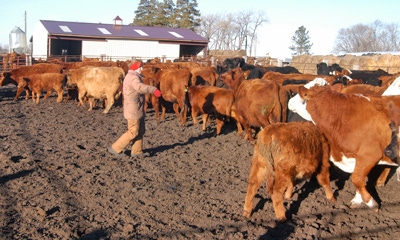July 5, 2016

Taylor Grussing, South Dakota State University Extension cow-calf field specialist, says to weigh these six things when selecting replacement heifers:
1. Age. Select heifers born early in the calving season that will reach puberty and first estrus before their younger herd mates. "These females are then also more likely to become bred and calve earlier in subsequent years, consistently weaning more pounds and being more profitable than later calving counterparts," Grussing says.
2. Genetics. "Replacement heifers should contain the best genetics in your herd," Grussing says. The best way to begin when selecting these high-quality genetics is by analyzing the genetics of your herd sire and dam.

STAY OR GO: A woman works cows and their calves. She will decide which heifer calves to keep to replace cows.
3. Scrotal circumference of the sire. This is associated with when his daughters reach puberty, as there is a moderate negative correlation between larger scrotal circumference and earlier attainment of puberty. On the dam side, disposition, calving ease, udder quality and milking ability are important parameters that should be analyzed. "By selecting heifers from cows that are easy to care for and can take care of their calves, you will also select for longevity and see her daughters and granddaughters being retained in consecutive years," Grussing says.
4. Phenotype. While it is important for some weight be placed on phenotype, Grussing says it should not be where the most focus is placed during heifer selection. "But while we are looking, we want to strive for selecting structurally correct females that can get around the pasture to graze," she says. Heavy-structured and large-footed females with a more correct angle to their shoulder and hock will rise to the top.
5. Heifer size. Size of the heifer is also important to consider. What will be her mature size and maintenance cost? Does your operation have the resources and environment to support her? "In this case, if the older females being selected are also larger, they may require more input to be maintained in the herd than smaller-framed counterparts," Grussing says. "However, small females can be very inefficient also." Having a good balance between the heifer's phenotype, weight per day of age and the cow’s mature size is important for profitability and efficiency of the cow herd.
6. Your business plans. Are you maintaining or expanding the size of your cow herd? The way you answer this question will help decide how many replacement heifers should be kept. "If the size of the cow herd is to be maintained, the culling rate should equal the replacement rate, right? Not necessarily," she says. "No matter if you are maintaining or expanding your herd, it is best to keep 10% to 15% more replacement heifers than actually needed, to account for the 5% to 10% of females that will be late bred or never become pregnant at all." This way, you will have enough to replace culled females, as well as extras to expand the herd or to be marketed. "In addition, if more females become pregnant than you need, you can increase selection pressure on which females have the best genetics to add to the cow herd," she says.
Source: SDSU
You May Also Like




